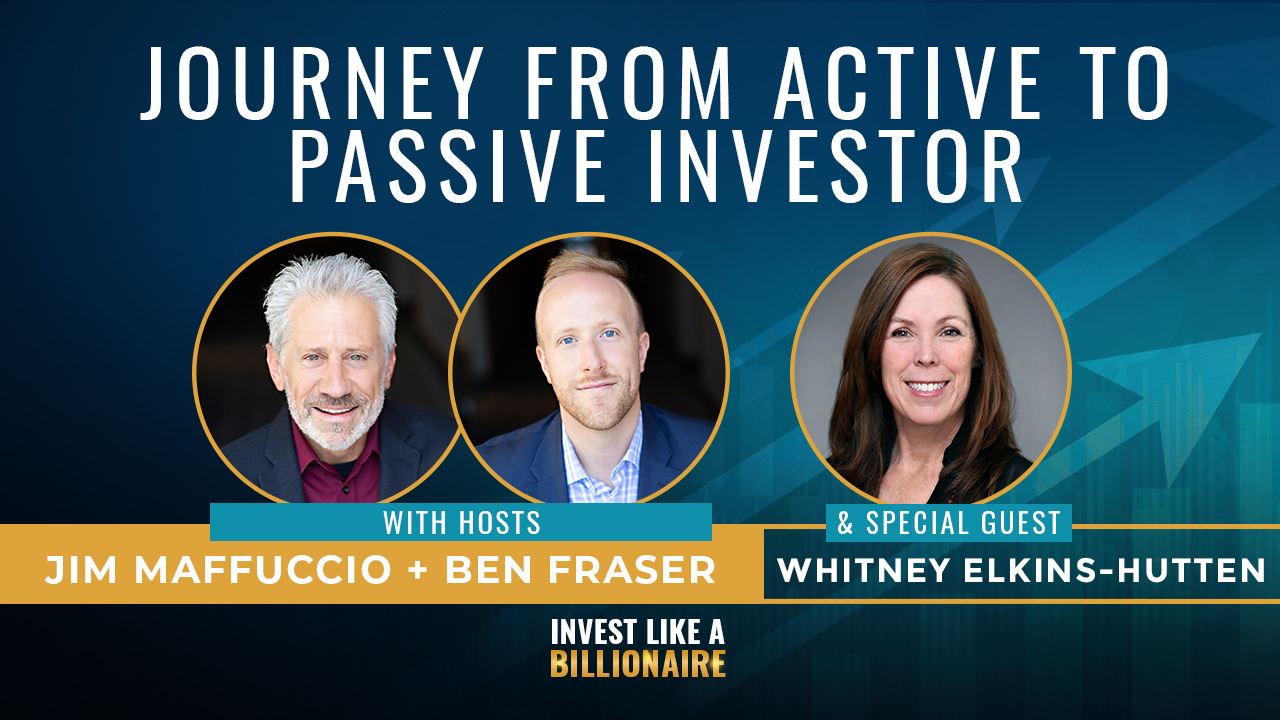
How do you start generating income from your investments and how do you transition that into a flow of passive income? Ben Fraser and Jim Maffuccio are back with real estate maven and director of Investor Education at Passive Investing, Whitney Elkins-Hutten, to learn more about passive investing and growing your assets. Whitney wholeheartedly believes that she’s living proof of just how successful anyone can be at real estate investing; all it takes is a little grit. Today, Whitney holds over 5000 residential units and more than 1400 self-storage units across eight states. Listen in as Whitney shares more of her story, including how she managed to grow her empire using the BRRRR-strategy, and how she funnels that forced equity into other passive strategies.
—
Watch the episode here:
Listen to the podcast here:
Journey from Active to Passive Investor – Interview with Whitney Elkins-Hutten
We are joined by a very special guest Whitney Hutten. We’re excited to have her on. She is a great educator in this space of passive investing. You’ve probably seen her around before. She has been around with several different groups, educating investors on passive investments, especially multifamily, as well as other asset classes. We’re excited to get her on this show and share her story a little bit.
She started as an active investor with the first rental many years ago, has transitioned and grown substantially from there and is working with PassiveInvesting.com, who some of you may know that name, doing large classy multifamily syndications. She’s the Director of Investor Education. I wanted to bring her on because she’s such a wealth of knowledge.
A real quick tidbit of what she’s done to what passive investing has done, passive investing has acquired over 4,000 units with a value of close to $750 million with about 1,400 investors that are active in those assets. She’s going to share some of her journeys but she’s a partner personally in over $700 million of real estate, over 5,000 residential units, including multifamily, mobile home parks, single-family, assisted living in more than 1,400 self-storage units across 7 states. Those are some very big numbers, Whitney, but it didn’t start that way. You started like a lot of people start in real estate of starting with rentals.
I started entirely by accident. I was buying a house with my significant other and the relationship completely fell apart. I had a house and I was scared like, “What do I do with this thing?” I had no idea. Financial independence, learning how to manage money, this was back in 2002. Wild Wild West of Lending and I was 103% financed on the property.
I shoved it fully roommate and immediately, it was in dire need of a rehab and spent the next year bringing the property up to snuff and I sold it. Probably shouldn’t have done that. I was probably the one person who read Rich Dad Poor Dad and got it wrong. He says, “Hold onto the real estate.” I sold it. I had walked away with more money with that one sale than I had been making my day job that whole year.
I was like, “I’m hooked. How many more of these projects can I do?” I continued doing that, brought my husband and me on a few projects afterwards. We realized that we were good at building equity but we weren’t good at building cashflow and unlocking the golden handcuffs. Why a lot of people love their day job is because they get a regular stable income coming in, benefits as well. It took us a few years to realize that we needed to take that equity and put it into rentals. It was like a slap on the head like, “That’s how they do it. They get rentals. Passive income. Got it.”
Passive income is still leverage money because you’re still treating an immense amount of time for money to come in. Share on XWe scaled up the portfolio of single-family properties both in Colorado but we quickly transitioned to out-of-state when we realized we could get better cashflow. It was off to the races from there but we hit an inflection point where I wanted more of my time back to spend with our family and I had done that but we hadn’t figured out what it took to get my husband out of his job. He said he wanted that too. I’m like, “We got to go bigger, level up our mindset and go into multifamily.” That’s where I both got started in both active and passive investing within multifamily. Fast forward, several years later, here I am, Director of Investor Education in PassiveInvesting.com.
That is awesome and there are so many nuggets there. I’d love to unpack a little bit of that but one of the things you said stood out to me where a lot of our audience is at as well is you’ve been intrigued by real estate. You’ve got bitten by the bug somehow, whether it’s yourself or from someone that you know. The natural assumption is to jump right to single-family rentals but it’s also the lowest barrier to entry. It doesn’t always translate to cashflow to your point.
That’s a whole unique skillset to find those right properties. It’s difficult in this market as well to find deals that cashflow, especially in a market like you’re in, like Boulder. Making that transition, what was the light bulb moment for you because you’re are still actively investing in a lot of these deals but you’re also passively investing and partnering with top tier operators and these asset classes that you like. Talk a little bit about that light bulb moment as well, moving more towards passive investing.
You and I are very active on BiggerPockets and a lot of people come to BiggerPockets. They’re enamored with real estate. They’re like, “I’ve got to go get my first rental. Passive income mailbox money.” I like to think of it more as leveraged money because you’re still treating an immense amount of time for money to come in but it’s incremental like $150 a month or $200 a month, maybe $300. If you’re lucky, you can get beyond that. We scaled a single-family portfolio through what we call the BRRRR model.
We were recycling our capital over again by buying properties that needed to be fixed up. That was tiring because I was getting two loans for every property. I had property management. I was coordinating in property management. I had some pretty good systems in place but even then, I was somewhere between being self-employed and a business owner. Our dreams were beyond having $5,000 or $10,000 a month coming in and I wanted $35,000, $40,000, $50,000, $100,000.
For the sake of the audience, you said the BRRRR method. That’s Buy, Rehab, Rent, Refinance and Repeat. That’s where a lot of people are. It is a great place to start but your aspirations, dreams and moving more towards a scalable model with less of your brain power per door. That’s what led you, so go ahead.

The natural progression there is like, “I figured out how to get 1 to 5 units under my belt. Can I do more in one transaction? Can I get a 5-unit, 10-unit, 20-unit property?” You have to understand what your goals are. Some people love it. That’s what they do. They want to live and breathe real estate. For me, I love real estate but real estate is a tool for me to achieve my end of, “This is not my house.” I wish it were. I have not taken a month off but we’re in Sedona, hanging out as a family, working and playing from here. What I want to do is travel, experience life and create these experiences not only for myself and my family.
Managing a property was not going to get me there. I had to rethink what my goals were and pick an investment strategy that aligned better with those goals. I was bitten by the bug of real estate and I was trying to solve all these challenges that a lot of people get sucked into as far as scaling and acquiring. Maybe the acquisition keys and all these things that you can build through actively managing multifamily. For me, I wanted my time back. The biggest return on my time was to invest passively. That could be a multifamily, in self-storage, manage or through notes. It’s when I aligned my investing with my true goals in life. That’s where our portfolio started to take off. We doubled down on passive investing and never looked back.
You must have heard somebody either at a conference, online or a webinar that opened your eyes to the world of multifamily investing. When and who and how did that happen?
I can’t remember the specific inflection tie-in on multifamily as an asset. Probably it was along the lines of listening to something with Robert Kiyosaki. I can tell you what happened when it dawned on me that passive investment is probably a very strong way that I wanted to scale. I had joined an investment group. I no longer work with them but I joined them to be on the active side of real estate because I thought that’s where I wanted to be. I’m a very driven person. “I can do it. I can figure it out. I’ll figure out how to balance life later.” That was always my MO. When I saw these powerhouse women balancing life first through passive investing, I was like, “This is the investment strategy.”
It’s how do you build the business or participate in a business as an investor, not so much as the active business owner. Everybody is going to have the different skillsets they bring. There are people out there that want to invest actively. I seek those people out to invest alongside them because it’s a win-win. They have the time knowledge, expertise, the hustle, the credit in lending, the access to the markets, access to the deals and so much so that they needed additional capital to take all these deals down. I have the capital. I figured out ways to create that capital. We can talk about that journey as well. It’s a win-win.
I take a limited partner position and I get a ROT, a Return Of my Time. I do get to share in the cashflow of the deal. I’d look for deals that have a preferred return, where I’m getting an X percentage of the first parts of the return. Asset look for splits and equity. I also look for a business plan to return my money as quickly as possible, so I can continue to create velocity with my money and go into more deals at the same time.
You have to understand what your goals are, rethink your goals, and pick an investment strategy that aligns with your goals. Share on XIf someone’s considering the active versus passive approach, I view an active investor. There are two primary motivations. One would be, you want to create income and you don’t have a lot of income or wealth yet to deploy passively. You want to do it more like a business or you have a passion for it. You love real estate. You have deal flow. You want to do it as a business but as someone who may be enjoyed as their 9:00 to 5:00, who has a great job or a great profession that they love, it’s not the best option for the most part.
If you have other ways to generate wealth and income, put that income away into these deals. A lot of the deals that you are putting out and other sponsors, you’re going to be making more money, at least the same passively without doing much of the work, if any, than you would if you’re trying to buy a rental or something on your own then having the headaches that go along with that.
What’s the highest and best use of your time? I’ve seen passive investors struggle with it because they’re like, “I want to take my money and get the highest return on it.” I’m like, “Yes, but what’s the cost of that?” If the deal goes well, active investors make a pretty hefty profit on the deal as they should because my most important non-renewable resource isn’t my money. It’s my time. Once I spend it, it’s gone. I can’t get it back. They’re giving me a precious gift by allowing me to keep my time and we split the profits.
Talk a little bit about the syndication model. A lot of our audience is familiar with that but for those that are maybe newer to real estate syndication, break that down. What part does the limited partner play? I’d love for you to dive into your role as the director of investor education. What does that mean? What do you do?
Syndication is group investing. You’re bringing a group of investors together to take down a larger deal that they probably individually didn’t have access to on their own. In syndication, there’s going to be a general partnership and a limited partnership. The general partnership, when you think about it, it’s an operating business. This is where I spend a lot of time with investors helping them reset and recalibrate their expectations because maybe they’re scaling up from holding their small multifamily or single-family and properties. They were the operator. They’re very drawn to the deal, so they’re looking for returns. When we get into syndication and investing, you’re investing in operating business.
We have to flip that model on its head. The deals and returns are important. We want to make sure they’re aligned but what you need to look for first is the operating team, the general partnership. Who are they? Vet them first. Do you know, love and trust them? Do you know their track record? What are their exits? What are the markets that they’re in? What are their investment strategies? Are they doing development or are they doing core properties with no value add to them? Are they somewhere in between?

Once we have found those operators that align with the investment strategy that you want, then we’re going to vet the markets they’re in. I like growth markets. I’m looking for operators that are investing in high-growth markets, where the jobs and populations are growing. Crime is trending down. Tax laws are favorable. If you’re talking about multifamily, landlord-tenant laws are favorable, then we’re going to stack all those investing cards in your favor with the market.
Where’s the part where we start looking at individual deals? You have to know your goals. You have to then find the operator that can help you meet those goals. Double-check everything about the markets that you’re going to be invested in, then it’s time to start looking at the deal. That’s what I help people do here at PassiveInvesting.com as the Director of Investor Education.
I love the framework. When you’re investing in syndication, you got to look at the jockey, the horse and the track that they’re on. The jockey is the operator. The horse is the deal and the track is the industry or the asset class that it’s in. Ideally, all three of those are in a positive direction. Arguably and you probably would agree that the jockey is the most important of those three. What do you tell passive investors that are newer to this? A lot of investors are getting into this mix.
There’s not a shortage of deal flow. You can go to the crowdfunding websites like CrowdStreet, Realty and Mogul. Maybe you get on some lists of other syndicators. Once you get into the mix, it feels almost overwhelming, the number of deals that are out there. Break down your framework for a passive investor because you are one and you work for an operator. Talk about what are the keys to finding the best operators.
First of all, I love your jockey and horse analogy because that’s not entirely what my experience working with investors in this space. They’re betting on the horse rather than understanding who was training in the horse or riding the horse. When you’re making that transition into passive investing, you need to understand. First of all, do you believe in real estate as an investment vehicle? That would be the number one thing that I would check. I’m very focused. My work with PassiveInvesting.com is in real estate, multifamily, self-storage, real estate back notes but Passive Investing can imply wealth. You can go into multitude of industries here.
For me, with real estate, do you believe in the investment vehicle, whatever the investment vehicle is? Do you want to be active or passive? Some people have the challenge of letting go of their passive portfolio. They feel like they’re providing more value if they’re actively involved in the project. Throw that on its head because I’m like, “If you’re passive, you can create a larger impact by diversifying your capital over multiple markets and multiple deals than you could if you took down 1 house and 1 market, a duplex or quad.” Once you’ve answered that question for yourself, do you want to be active or passive? We need to understand what is it that you need out of your passive investment. Do you need cashflow? Do you need or want appreciation? Do you need some balanced blend of both?
If you want your time back, the biggest return of your time is through investing passively. Share on XFor me, as a passive investor, I always look for deals that have cashflow and some equity growth built into them. This is a struggle too that some are an obstacle. Sometimes I hit with passive investors. There’ll be like, “I don’t need the income. I don’t need cashflow. Give me the appreciation.” That may not align with the business plan on a deal. I look for deals that have cashflow because that means they’re profitable now. I don’t have to wait for them to be profitable later. That generally gives a little bit of hint of the risk of the business plan of the asset if it doesn’t cashflow well now. Once you answered that question and for me, I like assets that have both cashflow and appreciation. I want the bump on the back end too.
I’m starting to get into like, “Who are the operators that are doing passive investing, cashflow deals and whatever asset class I’ve chosen, multifamily, self-storage?” That can help narrow down your focus and what investors or passive operators to look for. You can also talk to other investors that you know in your circle. What are they doing? Who do they know, love and trust?
There are several online forms that you can go on and several Amazing conferences. We’re going to be at Intelligent Investors Conference. Also, with the best conference. Those are two amazing conferences to attend for passive investors. Not only the knowledge in education that you can acquire there but if you want to be in a concentrated room with top-notch operators, there you go.
When you’re thinking about personal goals and personal investing strategy of income versus growth versus a hybrid and also risk tolerance, how do you overlay that framework on there for yourself?
That is something that a lot of people, especially when they’re getting into the world of passive investing don’t interrogate enough about ideal. There are several different points. For one, I look at the business plan. What type of business plan is it? Are you new ground-up construction? There is a different risk than a stabilized A property, which carries a different risk than a luxury A property in the urban infill. Those are all different align on a continuum. I’m not knocking development deals at all. You have to understand to carry a different risk profile.
Typically, they will have a different reward profile as well from something more of like suburban A class property. It’s helping the investor understand what the business plan is. It’s number one. Number two, helping them understand the loan. If the property is using leverage, what is the lending structure on that? You can have an amazing stabilized A-class property in an amazing area and if they’re using for whatever reason a construction loan to purchase it, we have some interest rates risk there to mitigate. As a vetted operations team, you’re going to mitigate a lot of those risks inherently upfront with the business land.

Talk a little bit about the deals that you are doing at passive investing. You focus primarily on class A multifamily, as well self-storage. I believe you have a lending fund but the class A is the bread and butter, multifamily deals or what you are doing. Talk a little bit about the investment thesis behind that and why you like those deals.
We started with the value-add B-class strategy. We’ve moved upwards toward that B-class and the A-class asset. In suburban areas, these are not your luxury infill downtown-type properties. These are very affordable. The average rent on our class-A properties is $1,500 a door, so you can multiply that gross rent times three. The household income needs to be about $45,000. In the markets that we’re in, the household income is $100,000 or more. These are very affordable properties.
That was a nice little hack right there you use that some people may not know. Gross rent times three, what does that even mean?
If the gross rent on the property is $1,500, you’re going to multiply that by three to qualify the tenant for the property. We were at $4,500 a month. As long as the household that’s going to be living in that unit makes $4,500 a month or more, we are probably not. They’re going to qualify for the unit. They’re technically according to US standards, not putting themselves upside down to live in the property. They’re not spending more than they should. They’re going to qualify for the unit. The household income is in the areas that we invest in is typically $100,000 or more.
Which is evidence of affordability for the rents that you are looking at.
You’re probably not going to have as much economic vacancy in those areas.
You have to think about what the highest and best use of your time is because most important non-renewable resource isn't money, it’s time. Share on XIt’s by account vacancy a little bit.
You can think of it in two different terms, physical vacancy or economic vacancy. This is where a lot of C-class properties got hammered during COVID. We all can understand vacancies, the property is occupied or it’s not. The tenant is there or they’re not but what if the tenant can’t leave or doesn’t want to leave but they’re not paying rent? That is an economic vacancy. We saw that during COVID when there was an eviction moratorium. We couldn’t move the tenant out. These C-class units, while they had a higher physical occupancy, their economic occupancy was lower because there tend to be service workers. They were losing their jobs and couldn’t pay the rent.
Class-A properties as a whole performed well from a rent collection standpoint because the underlying tenants had jobs that were not more at risk during COVID and were able to maintain employment.
That’s what we found. What COVID unfolded for us is that these new class-A properties, these are where upper-level management, supervisors and directors are living in these types of apartments. They were able to work from home. The job risk wasn’t there for them. They didn’t lose their job and generally weren’t suspended. Whereas, in areas that were more service industry-focused, we saw a lot of economic vacancy in those units.
I’ve heard lots of different arguments about all the different class A, B and C, pros and cons and the benefits drawbacks. One of the things that a lot of people say about class-A is if there’s an economic downturn, a lot of the tenants will trade down like a class-B property. It can be more susceptible to bigger hits in the economy. What you said goes against that, at least in the COVID era, which was maybe a different economic hit than maybe the Great Recession. Can you talk a little bit about how did class-A perform in the Great Recession? If you have some of that data or insights.

I don’t have the data directly in front of me but the class-A luxury is very distinguishing the two classes. The urban and classy luxury took a beating during COVID, both from a physical as well as an economic standpoint. That is your urban infill of downtown. That’s still is on the recovery. It took a beating during the Great Recession. These are $3,000, $4,000, $5,000 a unit property. You’re paying for the location or high amenities are on those properties. The class-A that we’re talking about here in our investing thesis is suburban class-A. These are the multifamily apartments that are being built. We’ve all seen them around our Metro areas in the past years. They’re outside the city centers. They’re still well located, close to jobs, great schools and markets.
Think about it this way. They’ve probably centered fifteen minutes from Whole Foods or something like that. One of our founders called it the whole circle. Whole Foods do amazing market research so does Starbucks. Those are great things to piggyback off of. When we’re talking about the Great Recession, I’m wondering if the data teased out the suburban A-class property. It wasn’t a big hot ticket item then. I’m wondering if the data teased out the difference in class-A because I’ve heard that too. Class-A goes down to B and B goes to C. Where does C go?
I think of it as a lot of people were displaced from homeownership during that timeframe. Where are they going to go? They’re going to go to the class-A suburban. You probably had people in filling those units, even as maybe some people had to move out and downgrade. That seems like a pretty safe, sweet spot. I can see where the luxury class gets hit in a situation like that.
Most people don’t give up their economic lifestyle. It’s hard. That’s the last thing they’re going to give up. They’re going to give up everything else before they give up their economic life.
There’s a lot of drivers behind multifamily. One is lifestyle choices but two, it’s also the affordability of homeownership. It’s becoming less affordable and that’s driving more renters. I like your thesis there. When you’re looking at your own personal investing strategy, how do you analyze a deal quickly? You probably see a ton of deal flow. I was investing in the deals you are doing but even outside of that, it comes from a personal standpoint. What are some ways that you’ve learned to analyze these deals quickly to decide if it’s a deal worth looking more into or not?
I think of it as a sales funnel. I am working through that whole funnel by figuring out who my operators are going to be my core operators. I’ve invested over ten operators. I’m always looking to expand that base but I don’t get on everybody’s list. I make sure that I’m very aligned with the operator. That’s number one. Number two, I’ll do all this pre-vetting in the market. I’ve already vetted the team and the markets they’re in. I’ve already aligned with their strategy before I start getting that deal flow.
People have the tendency to give up everything else before they give up their economic lifestyle. Share on XA lot of the heavy work is upfront but once I start getting the deal flow, what am I looking for then? Am I looking for multifamily, self-storage, residential assisted living or something else? I sit down once a quarter, maybe even more often, depending. July, August and September were hot months in 2021. I was constantly reevaluating what type of assets I wanted to go into. It’s knowing what I’m looking for right then.
If I’m looking at multifamily, I’m looking at the unit count. I look at 100 doors or more. There’s scalability there. You can have full-time employees on the property. I’m looking for that B-class asset and above. B plus is a huge sweet spot. I’m looking for those high-growth markets. I’m getting down into the actual business plan on the asset. Where are we in the market swinging for the fences on a huge value add? For me, it’s not in my risk tolerance because copper, lumber, all of these materials are all over the board. I’m chilling out in the heavier value add pieces. I love the additional streams of income part. Can your fiber internet to a property, valet trash, storage or package lockers increase the net operating income that way?
I start getting into the actual return metrics. If all the parts checkboxes for my business planner are in place, then I start getting into the return metrics. What’s the internal rate of return on the property? I needed to find out. We need a break out of the calculus calculator. What is the equity multiple on their property? How long is my money tied up for? What is the plan for me to get it back as quickly as possible? What is the preferred return on the property? I’m looking to double my money in about 5 years with the chance of getting my money returned or all or part of it returned much earlier than that in 2 to 3 years.
Whitney, I love that funnel idea. That’s super cool. A lot of investors make the mistake of jumping in and wanting to call it over diversify where you don’t want to take too many risks, so you think that if I diversify across maybe 20 different deals and 20 different operators, then it’s going to reduce my risk but you made a great point. You do all the work on the front end of the operators and decide, who aligns with my values and the strategists that I believe in?
You do all the hard work upfront. It simplifies the decision-making process because you’re looking at the deal they’re generating. Does it meet the other filters? I love that, especially the crowdfunding platforms. All things are available where you can log in and invest in a deal right there at the click of a few buttons. You still don’t know much about who’s behind it. What is their track record? Have you done background checks? I liked that framework. That’s cool.
Crowdfunding has a unique opportunity to serve somebody. If they wanted to kit tests like real estate with $10,000 or $5,000, in some small amount or if that’s the increments in which they can invest over time, that’s fine. At some point in time, you knew that somewhere along that continuum there are going to be larger chunks to invest. Try to manage 50,000 wants. The tax forms alone. Years ago, I have a heavy investing year. When I got to the tax forms at the end of the year, I was crying. “This is amazing but I got to do all this tax work.”

No kidding. One of our COO here at Aspen, we had an interview with him a while back. He said at one point he had $100 K-1s from all of his investments. He’s a CPA by trade and he didn’t mind it but I’m like, “That sounds like a nightmare.”
That’s great. There’s a lot of diversification. Hopefully, a lot of depreciation is being thrown off there. That’s a healthy problem to have as long as everything’s performing.
I doubt that his were $5,000 K-1s. Your point is well-taken on that. The over-diversification or spread the risk too, you can end up with a bunch of crummy little deals.
If you’re investing $5,000 here, $10,000 there, it’s hard to gain. I don’t have the math to prove it out. There’s probably a lot of friction in that. You’re not able to take full advantage of underwriting the assets. They’re probably going to do well and generate a lot of money for you.
That’s probably more of tuition than an investment at that level. You’re still learning. It’s a great way to learn. Nothing like having a little skin in the game to cause you to want to learn but you might take some knocks along the way but if you view that as, “I’m paying dues. I’m paying tuition,” until you have the capital base that you can invest passively, it can start becoming a significant part of your income and eventually, it can become your sole source of income. That’s where a lot of people want to get. It’s part of the journey.
It’s more exciting to get a $30,000 check on a $50,000 investment than a $3,000 check on a $10,000 investment.
From a personal investment standpoint, where are you thinking about putting your money? As you’re going into this New Year here in 2022, we have a very long economic cycle. We’ve had a long run in real estate. I like your thoughts on heavier value add. Maybe be a little more cautious on those. Make sure it’s the right deal. With the lighter value adds, it’s easy to add ancillary income streams that don’t require a lot of construction. You have a much lower risk there. What are some other things, even other asset classes that you’re personally excited about?
You are going to laugh but we closed one short-term rental. It fits in our investing plan because we’re doubling down on our lifestyle assets. We’re still looking at all these different passive investing deals. We’re looking for some short-term rentals in areas that we visit often. We’ll be personally utilizing them. It won’t be like our long-term polls where we’re $150, $200 to $300 a door. We’ll be generating a lot more capital and writing that way. On the passive side, I’m still a believer in multifamily. I love it. I come from the world of public health. Maslow’s law is the basis of all public health. People need food, water, warmth and a roof over their heads.
I’m still very much a believer there. With the housing being underbuilt by $4.5, $5 million, I’m seeing that number teeter back and forth in there. Self-storage is a hot asset. Jim, you talked about people for either lifestyle reasons or necessity multifamily is an option for them. You can’t pack in everything from a 3,000 square foot house into that type of unit. These multifamily don’t have garages. Self-storage is a no-brainer comparison or companion investment there. I dabble a little bit in ATMs. How can we bank the unbankable? I come at it from a different thought process than probably most people do but that is an area that I’ve been heavily investing in as well.
Whitney, this is awesome. You have super great insights. I know you just get started passive investing but you’re going to be doing some of those weekly webinars, series that I’ve seen you do before, that investor education. I love those weekly webinars you used to do. You tell us about what you’re going to be doing for investors and ways to get plugged in if investors want to hear more.
I do a weekly Passive Investing Made Simple masterclass. Visit PassiveInvestingWithWhitney.com and you can get plugged into it. I have a free unit checklist on Passive Investing Made Simple there that you can download. You can schedule some time to talk with me. I geek out about passive investing all day long, as you can tell. Also, you can get plugged in and learn what our masterclasses are. I’m also putting out some random YouTube videos and bringing people along for the ride with me.
Go reach out to Whitney. She’s a wealth of information. Thanks so much for joining us.
Thank you so much for having me. It’s been such a pleasure.
Important Links:
- PassiveInvesting.com
- Rich Dad Poor Dad
- BiggerPockets
- CrowdStreet
- Realty
- Mogul
- Intelligent Investors Conference
- PassiveInvestingWithWhitney.com
About Whitney Elkins-Hutton

Whitney Elkins-Hutten is the Director of Investor Education at PassiveInvesting. com and a partner in $700MM+ in real estate — including over 5000+ residential units (MF, MHP, SFR, and assisted living ) and more than 1400+ self-storage units across 8 states—and experience flipping over $3.0MM in residential real estate.







